A Comprehensive Report on Principles in Health and Social Care
VerifiedAdded on 2024/05/20
|21
|5464
|233
Report
AI Summary
This report provides a detailed overview of the core principles in health and social care practice, emphasizing their role in supporting vulnerable individuals and promoting societal well-being. It covers essential principles such as confidentiality, communication, equality, anti-discrimination, empathy, informed choice, and beneficence. The report also discusses safeguarding measures, relevant legislation including the Human Rights Act and the Care Act 2014, and the importance of person-centered care. Ethical dilemmas commonly encountered in healthcare, such as balancing patient autonomy with safety, are explored. Furthermore, the significance of rules, regulations, and codes of practice in ensuring effective and protected services is highlighted, with a focus on building trust and maintaining professional boundaries. The document concludes by underscoring the necessity of continuous improvement and collaboration within health and social care settings.
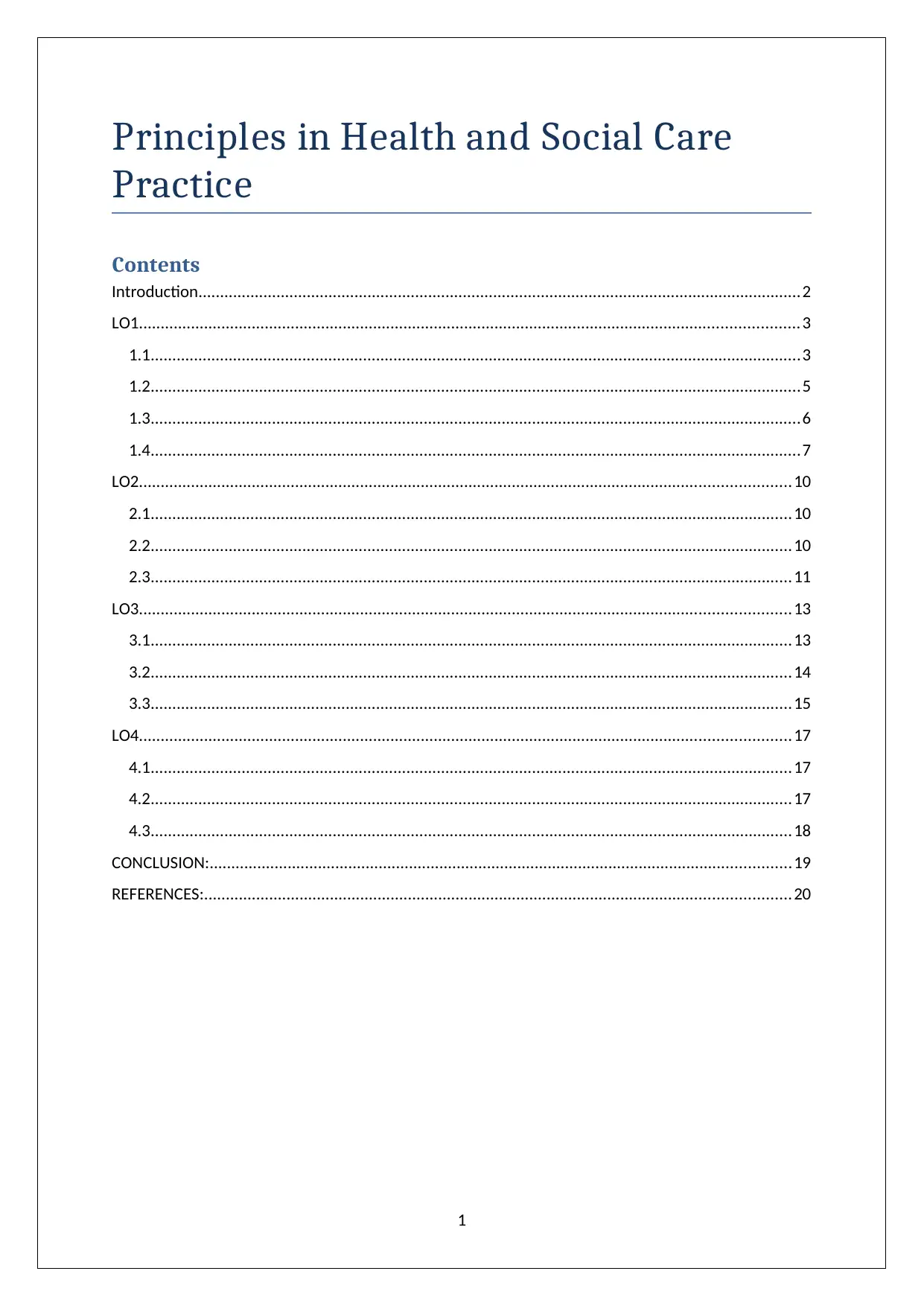
Principles in Health and Social Care
Practice
Contents
Introduction...........................................................................................................................................2
LO1........................................................................................................................................................3
1.1......................................................................................................................................................3
1.2......................................................................................................................................................5
1.3......................................................................................................................................................6
1.4......................................................................................................................................................7
LO2......................................................................................................................................................10
2.1....................................................................................................................................................10
2.2....................................................................................................................................................10
2.3....................................................................................................................................................11
LO3......................................................................................................................................................13
3.1....................................................................................................................................................13
3.2....................................................................................................................................................14
3.3....................................................................................................................................................15
LO4......................................................................................................................................................17
4.1....................................................................................................................................................17
4.2....................................................................................................................................................17
4.3....................................................................................................................................................18
CONCLUSION:......................................................................................................................................19
REFERENCES:.......................................................................................................................................20
1
Practice
Contents
Introduction...........................................................................................................................................2
LO1........................................................................................................................................................3
1.1......................................................................................................................................................3
1.2......................................................................................................................................................5
1.3......................................................................................................................................................6
1.4......................................................................................................................................................7
LO2......................................................................................................................................................10
2.1....................................................................................................................................................10
2.2....................................................................................................................................................10
2.3....................................................................................................................................................11
LO3......................................................................................................................................................13
3.1....................................................................................................................................................13
3.2....................................................................................................................................................14
3.3....................................................................................................................................................15
LO4......................................................................................................................................................17
4.1....................................................................................................................................................17
4.2....................................................................................................................................................17
4.3....................................................................................................................................................18
CONCLUSION:......................................................................................................................................19
REFERENCES:.......................................................................................................................................20
1
Paraphrase This Document
Need a fresh take? Get an instant paraphrase of this document with our AI Paraphraser
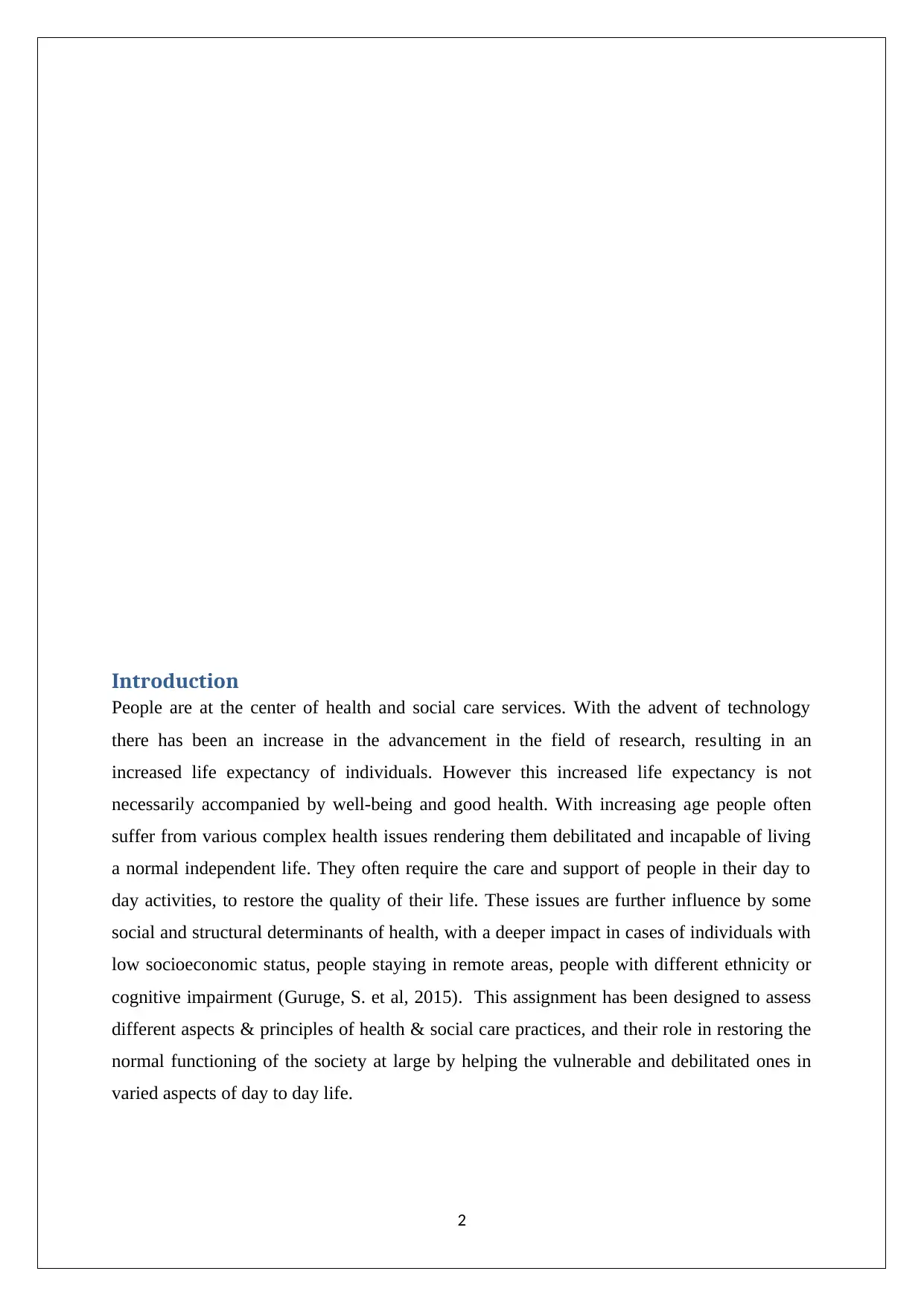
Introduction
People are at the center of health and social care services. With the advent of technology
there has been an increase in the advancement in the field of research, resulting in an
increased life expectancy of individuals. However this increased life expectancy is not
necessarily accompanied by well-being and good health. With increasing age people often
suffer from various complex health issues rendering them debilitated and incapable of living
a normal independent life. They often require the care and support of people in their day to
day activities, to restore the quality of their life. These issues are further influence by some
social and structural determinants of health, with a deeper impact in cases of individuals with
low socioeconomic status, people staying in remote areas, people with different ethnicity or
cognitive impairment (Guruge, S. et al, 2015). This assignment has been designed to assess
different aspects & principles of health & social care practices, and their role in restoring the
normal functioning of the society at large by helping the vulnerable and debilitated ones in
varied aspects of day to day life.
2
People are at the center of health and social care services. With the advent of technology
there has been an increase in the advancement in the field of research, resulting in an
increased life expectancy of individuals. However this increased life expectancy is not
necessarily accompanied by well-being and good health. With increasing age people often
suffer from various complex health issues rendering them debilitated and incapable of living
a normal independent life. They often require the care and support of people in their day to
day activities, to restore the quality of their life. These issues are further influence by some
social and structural determinants of health, with a deeper impact in cases of individuals with
low socioeconomic status, people staying in remote areas, people with different ethnicity or
cognitive impairment (Guruge, S. et al, 2015). This assignment has been designed to assess
different aspects & principles of health & social care practices, and their role in restoring the
normal functioning of the society at large by helping the vulnerable and debilitated ones in
varied aspects of day to day life.
2

LO1
1.1
There are certain fixed guidelines around which the health and social care services work to
provide maximum benefit to the service users. The purpose of these principles is to ensure
that individual are cared for without any breach of their basic rights and that their safety is
being ensured.
The main principles in health and social care practice include:
Confidentiality (Verity C, 2002): The principle of confidentiality is the cornerstone of health
and medical care services. An individual seeking health and social care has the right to expect
that the information entrusted by the individual will be dealt with confidentiality. However
the information may be shared among the caregivers to ensure safe and effective care of the
individual.
Communication: Effective communication skills are a must for a care giver to meet the
requirements of wide range of individuals they come in contact with in health and social care
setting and are considered as core clinical skill (Gysels, M., 2004). It helps them in building
positive relationships with the care users, their families, as well as other health care
professionals, and also ensures effective exchange of information among them to ensure
provision and implementation of effective care.
Equality & diversity: Equality in health & social care practice means that everyone has an
equal access to all healthcare services irrespective of their caste, creed, and socioeconomic
status. Individual’s personal or religious beliefs should be respected & acknowledged by
caregiver even if it is not shared by the caregiver in order to achieve success of the service &
to make the individual feel valued.
Diversity is basically an indicator of multicultural, multifaith, multidimensional nature of
human society. To respect diversity means accepting and respecting the beliefs, thoughts and
culture of different individuals.
Anti-Discriminative policy: It ensures that there is no discrimination made on the basis of
age, sex, race, caste, creed, ethnicity thereby ensuring successful care giving. In practicality
the measures that could be taken to avoid discrimination include availability of variety of diet
options to suits individual need and believes, to have information available and accessible in
3
1.1
There are certain fixed guidelines around which the health and social care services work to
provide maximum benefit to the service users. The purpose of these principles is to ensure
that individual are cared for without any breach of their basic rights and that their safety is
being ensured.
The main principles in health and social care practice include:
Confidentiality (Verity C, 2002): The principle of confidentiality is the cornerstone of health
and medical care services. An individual seeking health and social care has the right to expect
that the information entrusted by the individual will be dealt with confidentiality. However
the information may be shared among the caregivers to ensure safe and effective care of the
individual.
Communication: Effective communication skills are a must for a care giver to meet the
requirements of wide range of individuals they come in contact with in health and social care
setting and are considered as core clinical skill (Gysels, M., 2004). It helps them in building
positive relationships with the care users, their families, as well as other health care
professionals, and also ensures effective exchange of information among them to ensure
provision and implementation of effective care.
Equality & diversity: Equality in health & social care practice means that everyone has an
equal access to all healthcare services irrespective of their caste, creed, and socioeconomic
status. Individual’s personal or religious beliefs should be respected & acknowledged by
caregiver even if it is not shared by the caregiver in order to achieve success of the service &
to make the individual feel valued.
Diversity is basically an indicator of multicultural, multifaith, multidimensional nature of
human society. To respect diversity means accepting and respecting the beliefs, thoughts and
culture of different individuals.
Anti-Discriminative policy: It ensures that there is no discrimination made on the basis of
age, sex, race, caste, creed, ethnicity thereby ensuring successful care giving. In practicality
the measures that could be taken to avoid discrimination include availability of variety of diet
options to suits individual need and believes, to have information available and accessible in
3
⊘ This is a preview!⊘
Do you want full access?
Subscribe today to unlock all pages.

Trusted by 1+ million students worldwide
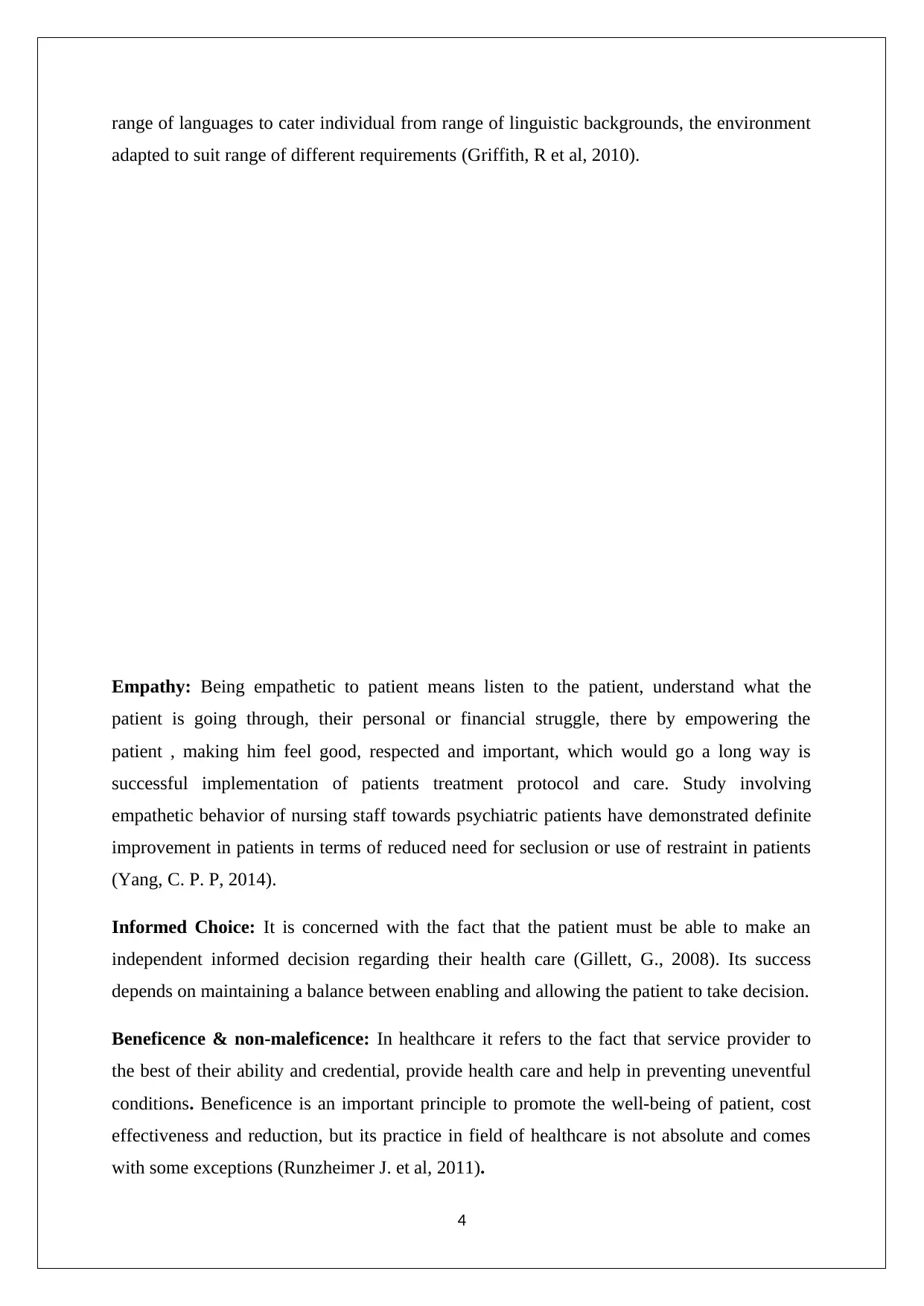
range of languages to cater individual from range of linguistic backgrounds, the environment
adapted to suit range of different requirements (Griffith, R et al, 2010).
Empathy: Being empathetic to patient means listen to the patient, understand what the
patient is going through, their personal or financial struggle, there by empowering the
patient , making him feel good, respected and important, which would go a long way is
successful implementation of patients treatment protocol and care. Study involving
empathetic behavior of nursing staff towards psychiatric patients have demonstrated definite
improvement in patients in terms of reduced need for seclusion or use of restraint in patients
(Yang, C. P. P, 2014).
Informed Choice: It is concerned with the fact that the patient must be able to make an
independent informed decision regarding their health care (Gillett, G., 2008). Its success
depends on maintaining a balance between enabling and allowing the patient to take decision.
Beneficence & non-maleficence: In healthcare it refers to the fact that service provider to
the best of their ability and credential, provide health care and help in preventing uneventful
conditions. Beneficence is an important principle to promote the well-being of patient, cost
effectiveness and reduction, but its practice in field of healthcare is not absolute and comes
with some exceptions (Runzheimer J. et al, 2011).
4
IMPACTOFDISCRIMINATIONINHEALTH&SOCIALCAREPRACTICELOSSOFFAITHSTRESSWITHDRAWALPHENOMENONLACKOFCONFIDENCEREDUCEDACCEPTABILITYOFCARESOCIALSECLUSIONANXIETYANDDEPRESSIONAVOIDANCEOFSUPPORT&TREATMENT
adapted to suit range of different requirements (Griffith, R et al, 2010).
Empathy: Being empathetic to patient means listen to the patient, understand what the
patient is going through, their personal or financial struggle, there by empowering the
patient , making him feel good, respected and important, which would go a long way is
successful implementation of patients treatment protocol and care. Study involving
empathetic behavior of nursing staff towards psychiatric patients have demonstrated definite
improvement in patients in terms of reduced need for seclusion or use of restraint in patients
(Yang, C. P. P, 2014).
Informed Choice: It is concerned with the fact that the patient must be able to make an
independent informed decision regarding their health care (Gillett, G., 2008). Its success
depends on maintaining a balance between enabling and allowing the patient to take decision.
Beneficence & non-maleficence: In healthcare it refers to the fact that service provider to
the best of their ability and credential, provide health care and help in preventing uneventful
conditions. Beneficence is an important principle to promote the well-being of patient, cost
effectiveness and reduction, but its practice in field of healthcare is not absolute and comes
with some exceptions (Runzheimer J. et al, 2011).
4
IMPACTOFDISCRIMINATIONINHEALTH&SOCIALCAREPRACTICELOSSOFFAITHSTRESSWITHDRAWALPHENOMENONLACKOFCONFIDENCEREDUCEDACCEPTABILITYOFCARESOCIALSECLUSIONANXIETYANDDEPRESSIONAVOIDANCEOFSUPPORT&TREATMENT
Paraphrase This Document
Need a fresh take? Get an instant paraphrase of this document with our AI Paraphraser
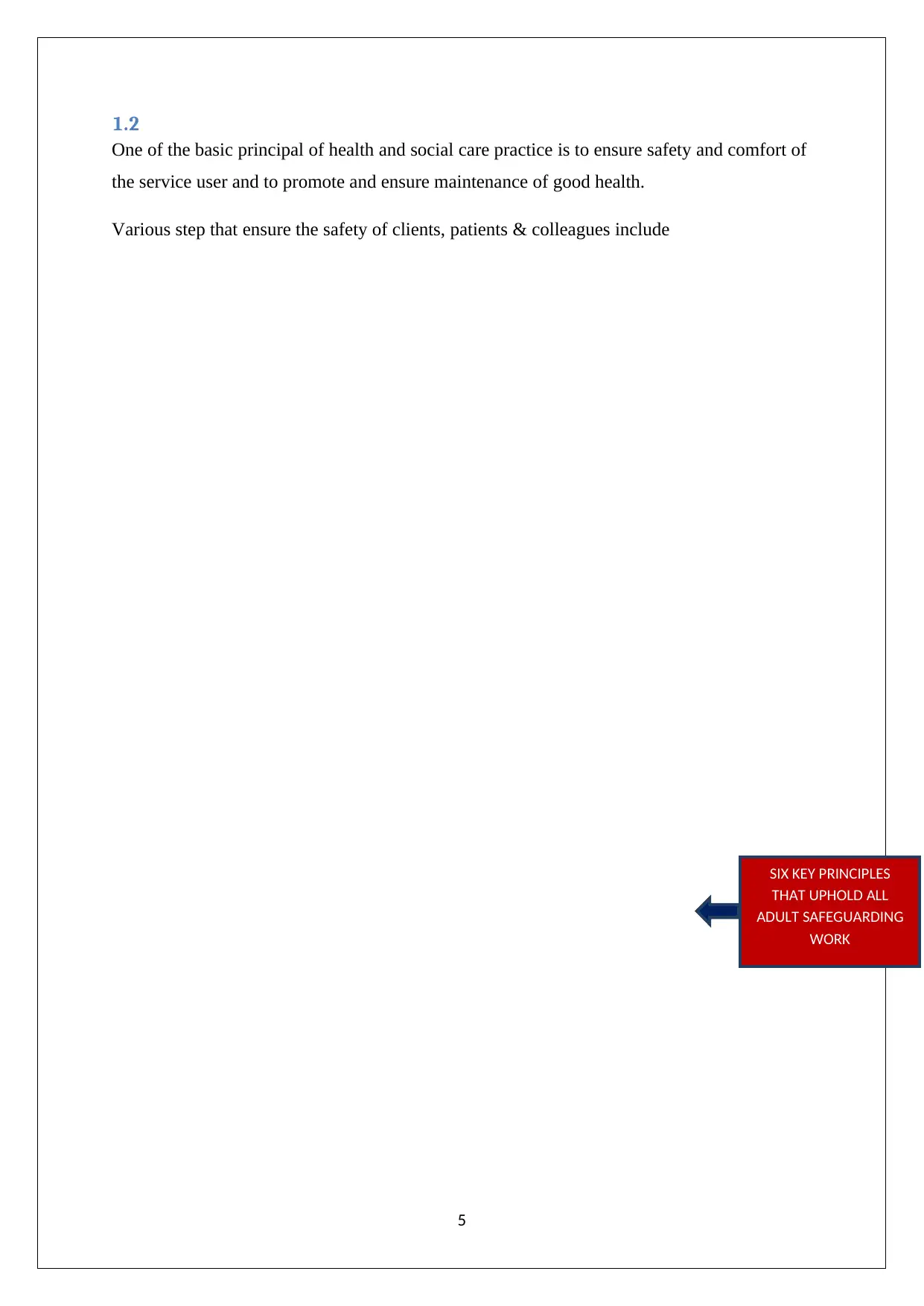
1.2
One of the basic principal of health and social care practice is to ensure safety and comfort of
the service user and to promote and ensure maintenance of good health.
Various step that ensure the safety of clients, patients & colleagues include
5
IDENTIFICATIONOFRISKFACTORSFORCAREGIVERSMEASURESTOCORRECTTHERISKFACTORRAISINGALERTDEVOLOPINGPOLICIESTOPROTECTTHERIGHTSOFCAREGIVERANDUSERMAINTAINANCEOFPROPERRECORDSCOLLABORATIONAMONGDIFFERENTWORKINGPROFESSIONALSMAKINGREFERRALEMPOWERMENT:toencourageinformedandindependentdecisionmakingbyindividuals,therebygivingthemthedrivingseatintheircare.PREVENTION:ItisacrucialprinciplethatmeansavoidingthedevelopmentofriskfactorsandtherebyneedforsafeguardingthevulnerableindividualsPROPORTIONALITY:Theneedsofthepersonaretakenintoaccount,tohaveatailormaderesponsetoeachone.PROTECTION:Tosupportandrepresentthemostvulnerable.Tohaveknowledgeaboutthesafeguardingguidelinestobefollowedandauthoritiestobecontactedwheneverneeded.PARTNERSHIP:Collaborationamongdifferentprofessionals,aswellaslocalandhighergovernmentagenciestoensureearlyidentificationofabuseorneglect.ACCOUNTABILITY:Toberesponsibleforone'sactiondonetoprotectthevulnerableanddependent.SIX KEY PRINCIPLES
THAT UPHOLD ALL
ADULT SAFEGUARDING
WORK
One of the basic principal of health and social care practice is to ensure safety and comfort of
the service user and to promote and ensure maintenance of good health.
Various step that ensure the safety of clients, patients & colleagues include
5
IDENTIFICATIONOFRISKFACTORSFORCAREGIVERSMEASURESTOCORRECTTHERISKFACTORRAISINGALERTDEVOLOPINGPOLICIESTOPROTECTTHERIGHTSOFCAREGIVERANDUSERMAINTAINANCEOFPROPERRECORDSCOLLABORATIONAMONGDIFFERENTWORKINGPROFESSIONALSMAKINGREFERRALEMPOWERMENT:toencourageinformedandindependentdecisionmakingbyindividuals,therebygivingthemthedrivingseatintheircare.PREVENTION:ItisacrucialprinciplethatmeansavoidingthedevelopmentofriskfactorsandtherebyneedforsafeguardingthevulnerableindividualsPROPORTIONALITY:Theneedsofthepersonaretakenintoaccount,tohaveatailormaderesponsetoeachone.PROTECTION:Tosupportandrepresentthemostvulnerable.Tohaveknowledgeaboutthesafeguardingguidelinestobefollowedandauthoritiestobecontactedwheneverneeded.PARTNERSHIP:Collaborationamongdifferentprofessionals,aswellaslocalandhighergovernmentagenciestoensureearlyidentificationofabuseorneglect.ACCOUNTABILITY:Toberesponsibleforone'sactiondonetoprotectthevulnerableanddependent.SIX KEY PRINCIPLES
THAT UPHOLD ALL
ADULT SAFEGUARDING
WORK

Some legislations have been passed that have an impact on health and social care mainly
Human Rights Act, 1998, Mental Capacity Act 2005, National Health Service Act 2006
Section 140, Mental Health Act 2007, Equality Act 2010, Care Act 2014.
1.3
Person centered care has become a symbol of good quality care. Person centered care has
resulted in increased rapport between the care providers and patients in terms of treatment
plans, treatment outcomes, patient’s faith & acceptance, level of satisfaction. Although
person centered approach has been acknowledged as an integral part of health and social care
practices, there are considerable hindrances in its successful clinical implementation. Person
centric care believes that the success of any treatment in a way depends upon the warmth,
care, genuineness and understanding on the part of care provider. Person centered approach is
not an individual technique but a family of approaches that aim at giving disabled individuals
control of their lives, and ensuring that they are being respected (Todd, 2002). Person
centered approach has 4 key elements
6
KEYELEMENTSOFPERSONCENTRICAPPROACH
Human Rights Act, 1998, Mental Capacity Act 2005, National Health Service Act 2006
Section 140, Mental Health Act 2007, Equality Act 2010, Care Act 2014.
1.3
Person centered care has become a symbol of good quality care. Person centered care has
resulted in increased rapport between the care providers and patients in terms of treatment
plans, treatment outcomes, patient’s faith & acceptance, level of satisfaction. Although
person centered approach has been acknowledged as an integral part of health and social care
practices, there are considerable hindrances in its successful clinical implementation. Person
centric care believes that the success of any treatment in a way depends upon the warmth,
care, genuineness and understanding on the part of care provider. Person centered approach is
not an individual technique but a family of approaches that aim at giving disabled individuals
control of their lives, and ensuring that they are being respected (Todd, 2002). Person
centered approach has 4 key elements
6
KEYELEMENTSOFPERSONCENTRICAPPROACH
⊘ This is a preview!⊘
Do you want full access?
Subscribe today to unlock all pages.

Trusted by 1+ million students worldwide
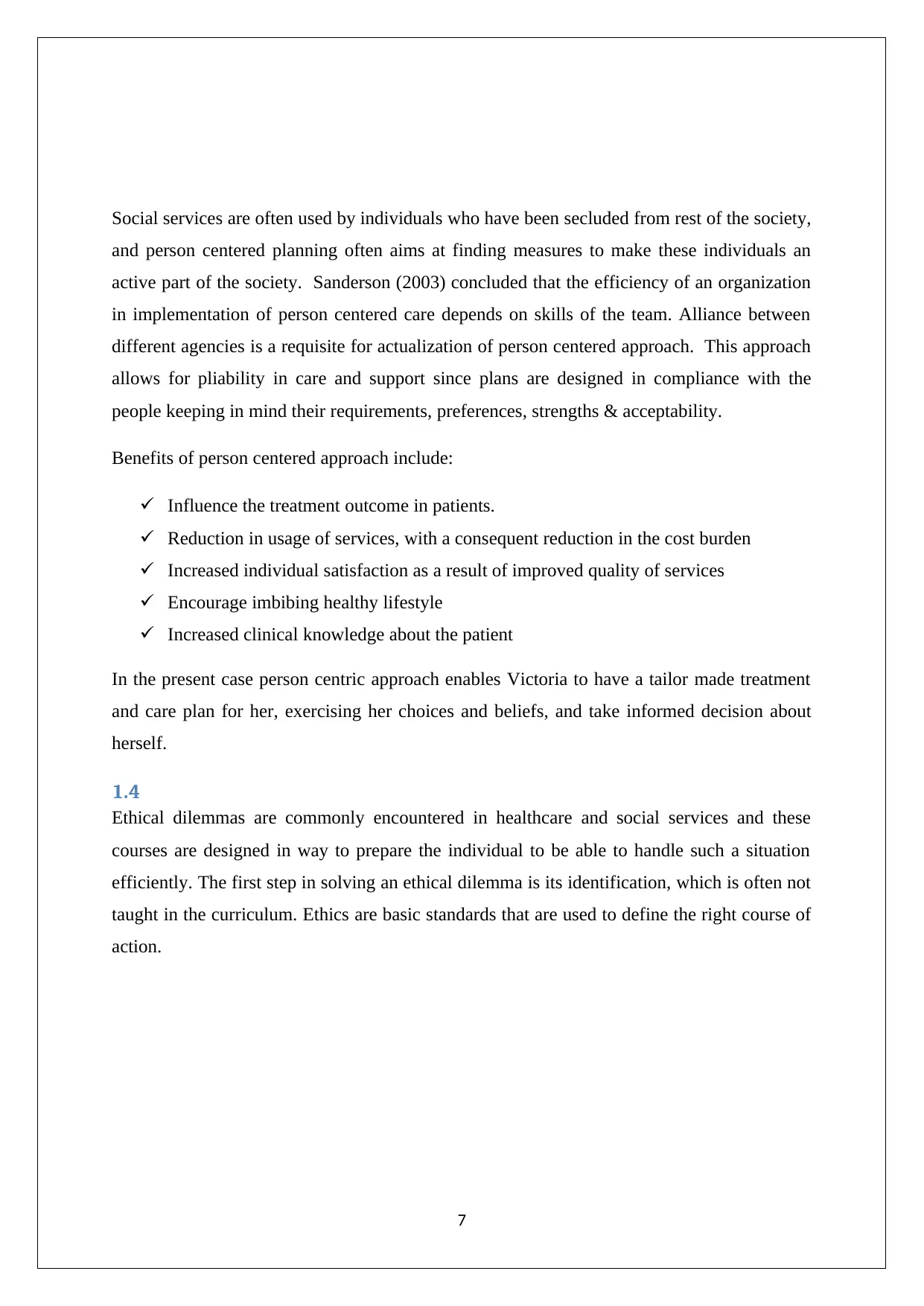
Social services are often used by individuals who have been secluded from rest of the society,
and person centered planning often aims at finding measures to make these individuals an
active part of the society. Sanderson (2003) concluded that the efficiency of an organization
in implementation of person centered care depends on skills of the team. Alliance between
different agencies is a requisite for actualization of person centered approach. This approach
allows for pliability in care and support since plans are designed in compliance with the
people keeping in mind their requirements, preferences, strengths & acceptability.
Benefits of person centered approach include:
Influence the treatment outcome in patients.
Reduction in usage of services, with a consequent reduction in the cost burden
Increased individual satisfaction as a result of improved quality of services
Encourage imbibing healthy lifestyle
Increased clinical knowledge about the patient
In the present case person centric approach enables Victoria to have a tailor made treatment
and care plan for her, exercising her choices and beliefs, and take informed decision about
herself.
1.4
Ethical dilemmas are commonly encountered in healthcare and social services and these
courses are designed in way to prepare the individual to be able to handle such a situation
efficiently. The first step in solving an ethical dilemma is its identification, which is often not
taught in the curriculum. Ethics are basic standards that are used to define the right course of
action.
7
and person centered planning often aims at finding measures to make these individuals an
active part of the society. Sanderson (2003) concluded that the efficiency of an organization
in implementation of person centered care depends on skills of the team. Alliance between
different agencies is a requisite for actualization of person centered approach. This approach
allows for pliability in care and support since plans are designed in compliance with the
people keeping in mind their requirements, preferences, strengths & acceptability.
Benefits of person centered approach include:
Influence the treatment outcome in patients.
Reduction in usage of services, with a consequent reduction in the cost burden
Increased individual satisfaction as a result of improved quality of services
Encourage imbibing healthy lifestyle
Increased clinical knowledge about the patient
In the present case person centric approach enables Victoria to have a tailor made treatment
and care plan for her, exercising her choices and beliefs, and take informed decision about
herself.
1.4
Ethical dilemmas are commonly encountered in healthcare and social services and these
courses are designed in way to prepare the individual to be able to handle such a situation
efficiently. The first step in solving an ethical dilemma is its identification, which is often not
taught in the curriculum. Ethics are basic standards that are used to define the right course of
action.
7
Paraphrase This Document
Need a fresh take? Get an instant paraphrase of this document with our AI Paraphraser
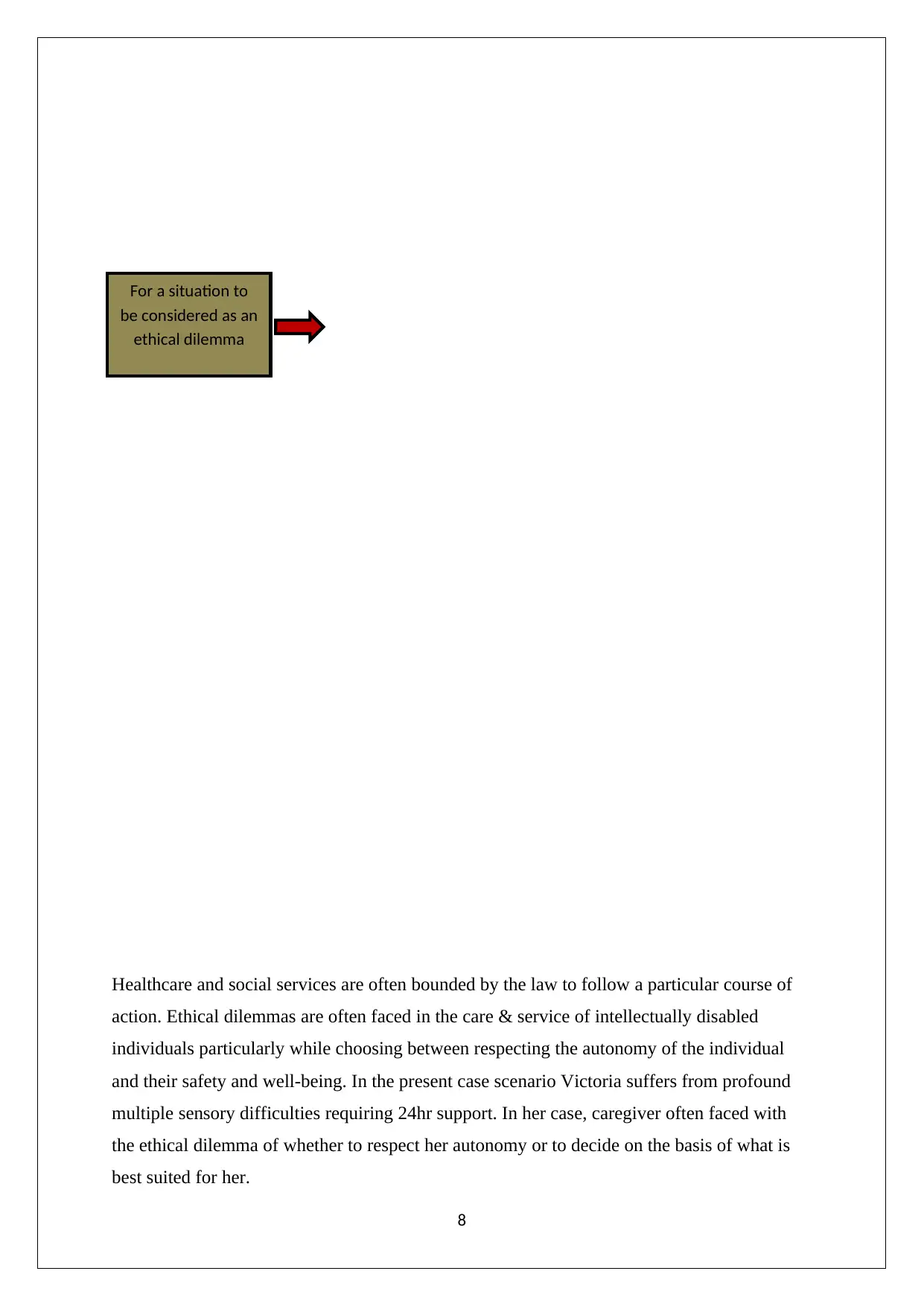
Healthcare and social services are often bounded by the law to follow a particular course of
action. Ethical dilemmas are often faced in the care & service of intellectually disabled
individuals particularly while choosing between respecting the autonomy of the individual
and their safety and well-being. In the present case scenario Victoria suffers from profound
multiple sensory difficulties requiring 24hr support. In her case, caregiver often faced with
the ethical dilemma of whether to respect her autonomy or to decide on the basis of what is
best suited for her.
8
PersonrequiredtotakedecisionaboutthebestcourseofactionAvailibilityofdifferentcourseofactionthatcouldbetakenEithercourseofactionscompromisesomeethicalprincipleEthicalTheoriesConsequentialism:BasedonresutlsofdecisonintermsofwellbeingoftheindividuaDeontology:BasedonobligationsanddutiestowardspersonorsocietyPrinciplism:Bringsoutthebestprinciplesofalltheories.Basedon4keyprinciples:i)Autonomyii)BeneficVirtue-ethics:Decisionsaremadeonthebasisofmoralcharacters&viFor a situation to
be considered as an
ethical dilemma
action. Ethical dilemmas are often faced in the care & service of intellectually disabled
individuals particularly while choosing between respecting the autonomy of the individual
and their safety and well-being. In the present case scenario Victoria suffers from profound
multiple sensory difficulties requiring 24hr support. In her case, caregiver often faced with
the ethical dilemma of whether to respect her autonomy or to decide on the basis of what is
best suited for her.
8
PersonrequiredtotakedecisionaboutthebestcourseofactionAvailibilityofdifferentcourseofactionthatcouldbetakenEithercourseofactionscompromisesomeethicalprincipleEthicalTheoriesConsequentialism:BasedonresutlsofdecisonintermsofwellbeingoftheindividuaDeontology:BasedonobligationsanddutiestowardspersonorsocietyPrinciplism:Bringsoutthebestprinciplesofalltheories.Basedon4keyprinciples:i)Autonomyii)BeneficVirtue-ethics:Decisionsaremadeonthebasisofmoralcharacters&viFor a situation to
be considered as an
ethical dilemma

While dealing with infectious disease interventions are often taken that may seem to breach
individual rights but are often intended to the larger benefit of the society. For e.g.
government agencies often carry out compulsory vaccination drives to prevent the occurrence
of infectious diseases. This may be supported by the principle of doing a larger good for the
society (Phua, K.L., 2013).
While gaining informed consent from individuals with serious conditions healthcare and
social service providers may be asked about their interpretation of the condition, by the
service user. In this case they often face the ethical dilemma of how much information to be
shared with the patient
Sometime there is an ethical issue related to the lack of competence in fellow colleagues, as
to whether this should be shared in order to ensure safety and well-being of the patient.
9
individual rights but are often intended to the larger benefit of the society. For e.g.
government agencies often carry out compulsory vaccination drives to prevent the occurrence
of infectious diseases. This may be supported by the principle of doing a larger good for the
society (Phua, K.L., 2013).
While gaining informed consent from individuals with serious conditions healthcare and
social service providers may be asked about their interpretation of the condition, by the
service user. In this case they often face the ethical dilemma of how much information to be
shared with the patient
Sometime there is an ethical issue related to the lack of competence in fellow colleagues, as
to whether this should be shared in order to ensure safety and well-being of the patient.
9
⊘ This is a preview!⊘
Do you want full access?
Subscribe today to unlock all pages.

Trusted by 1+ million students worldwide
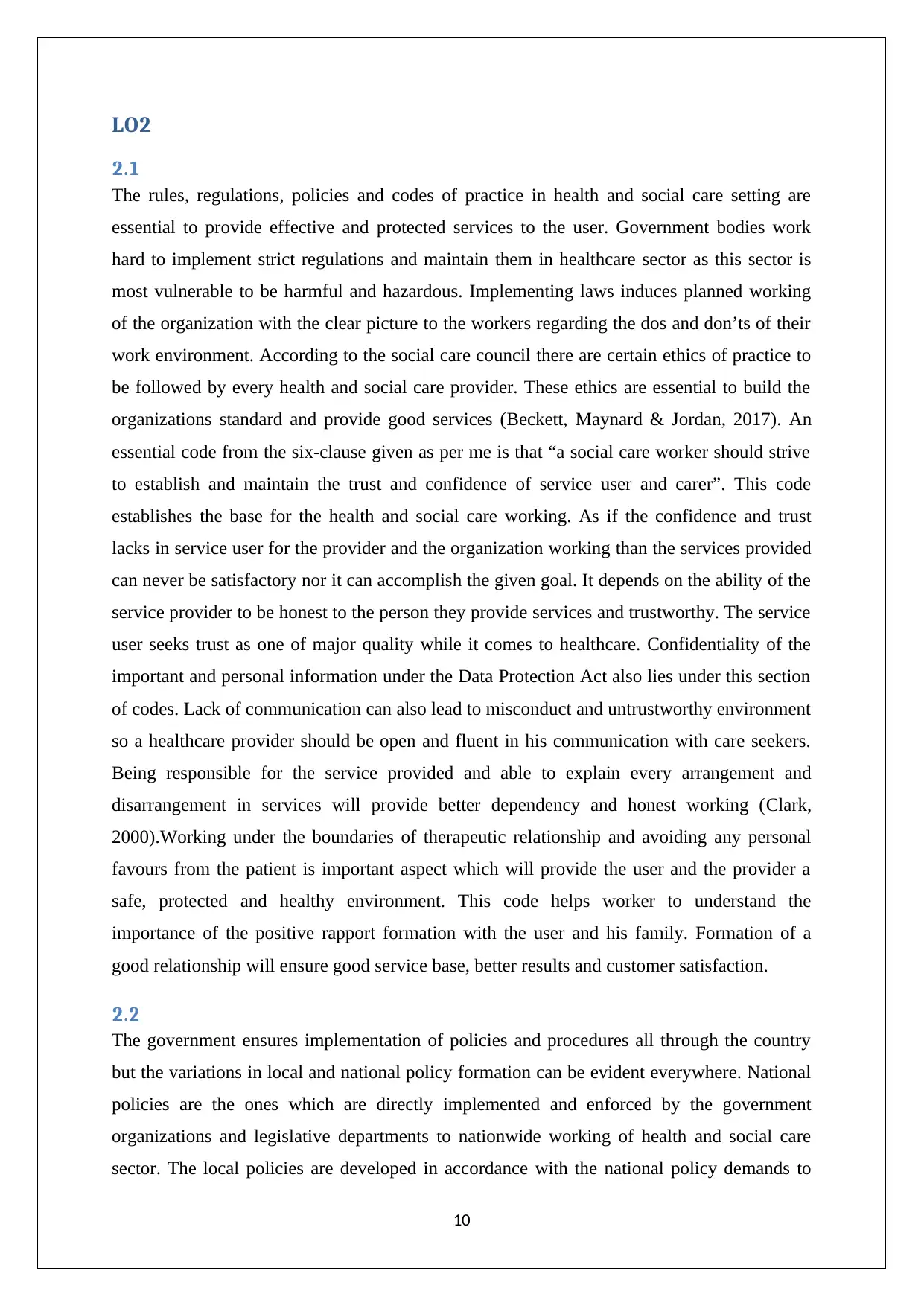
LO2
2.1
The rules, regulations, policies and codes of practice in health and social care setting are
essential to provide effective and protected services to the user. Government bodies work
hard to implement strict regulations and maintain them in healthcare sector as this sector is
most vulnerable to be harmful and hazardous. Implementing laws induces planned working
of the organization with the clear picture to the workers regarding the dos and don’ts of their
work environment. According to the social care council there are certain ethics of practice to
be followed by every health and social care provider. These ethics are essential to build the
organizations standard and provide good services (Beckett, Maynard & Jordan, 2017). An
essential code from the six-clause given as per me is that “a social care worker should strive
to establish and maintain the trust and confidence of service user and carer”. This code
establishes the base for the health and social care working. As if the confidence and trust
lacks in service user for the provider and the organization working than the services provided
can never be satisfactory nor it can accomplish the given goal. It depends on the ability of the
service provider to be honest to the person they provide services and trustworthy. The service
user seeks trust as one of major quality while it comes to healthcare. Confidentiality of the
important and personal information under the Data Protection Act also lies under this section
of codes. Lack of communication can also lead to misconduct and untrustworthy environment
so a healthcare provider should be open and fluent in his communication with care seekers.
Being responsible for the service provided and able to explain every arrangement and
disarrangement in services will provide better dependency and honest working (Clark,
2000).Working under the boundaries of therapeutic relationship and avoiding any personal
favours from the patient is important aspect which will provide the user and the provider a
safe, protected and healthy environment. This code helps worker to understand the
importance of the positive rapport formation with the user and his family. Formation of a
good relationship will ensure good service base, better results and customer satisfaction.
2.2
The government ensures implementation of policies and procedures all through the country
but the variations in local and national policy formation can be evident everywhere. National
policies are the ones which are directly implemented and enforced by the government
organizations and legislative departments to nationwide working of health and social care
sector. The local policies are developed in accordance with the national policy demands to
10
2.1
The rules, regulations, policies and codes of practice in health and social care setting are
essential to provide effective and protected services to the user. Government bodies work
hard to implement strict regulations and maintain them in healthcare sector as this sector is
most vulnerable to be harmful and hazardous. Implementing laws induces planned working
of the organization with the clear picture to the workers regarding the dos and don’ts of their
work environment. According to the social care council there are certain ethics of practice to
be followed by every health and social care provider. These ethics are essential to build the
organizations standard and provide good services (Beckett, Maynard & Jordan, 2017). An
essential code from the six-clause given as per me is that “a social care worker should strive
to establish and maintain the trust and confidence of service user and carer”. This code
establishes the base for the health and social care working. As if the confidence and trust
lacks in service user for the provider and the organization working than the services provided
can never be satisfactory nor it can accomplish the given goal. It depends on the ability of the
service provider to be honest to the person they provide services and trustworthy. The service
user seeks trust as one of major quality while it comes to healthcare. Confidentiality of the
important and personal information under the Data Protection Act also lies under this section
of codes. Lack of communication can also lead to misconduct and untrustworthy environment
so a healthcare provider should be open and fluent in his communication with care seekers.
Being responsible for the service provided and able to explain every arrangement and
disarrangement in services will provide better dependency and honest working (Clark,
2000).Working under the boundaries of therapeutic relationship and avoiding any personal
favours from the patient is important aspect which will provide the user and the provider a
safe, protected and healthy environment. This code helps worker to understand the
importance of the positive rapport formation with the user and his family. Formation of a
good relationship will ensure good service base, better results and customer satisfaction.
2.2
The government ensures implementation of policies and procedures all through the country
but the variations in local and national policy formation can be evident everywhere. National
policies are the ones which are directly implemented and enforced by the government
organizations and legislative departments to nationwide working of health and social care
sector. The local policies are developed in accordance with the national policy demands to
10
Paraphrase This Document
Need a fresh take? Get an instant paraphrase of this document with our AI Paraphraser

plan a proper working of own organization by the organization authorities. As the code of
ethics discussed before these codes are also responsible for formation of a local
organizational policy for the workers in accordance to national demands. The confidentiality
and trust code as discussed above is important and should be included in local policy even.
According to the Data Protection Act, 1998 the confidentiality of personal and health
information or any kind of information regarding the service user should be kept enclosed
and confidential by the healthcare workers and any error in providing this assurance and
coverage may lead to legal consequences too (PCT, 1998). As the code of practice describes
need for trustworthy environment same the national policy demands and the organizations
working should add this point to supreme importance. As to attain service user confidence is
the key to providing better services. Another practice to be implemented is the respect for
every individual and culture and belief of the user. As per the Health and Safety at Work Act,
1974 it is mandatory for every healthcare organization to ensure safe and protected
environment to the service user and carers both (Worsley, 1978). The protection also consists
of prevention from harm and abuse of any kind and protection of one’s dignity and respect.
The chief aim of the organization and its employees should be to administer all the
requirements of the service user and provide them with protected and healthy environment.
These policies and codes of practice helps the organization to build a plan for easy working
of the healthcare and it also provides template for service provider to follow and prevent any
misconduct (Pringle, Johnston& Buchanan, 2015).
2.3
The policies, procedure and codes of practice have great impact on any organizations
working as it allows the organization to follow a proper path to achieve their goals (Hart &
Bond, 1995).Rules and regulations always ensure proper service delivery and prevent
maximum error that can occur in absence of these policies. The regulations and policies will
bring a reform in organizations working and improve the working by manipulating the
limitations in service base. The main aim of these policies and regulation is to ensure proper
delivery of services with maintenance of the organizational standards. The quality of service
depends on the implementation of appropriate rules and regulation that will enhance the
working of healthcare and provide better results for the users. Providing the local policy of an
organization to the employees makes it clear and pertinent for them to follow the rules as
template to achieve the desired quality in services. Safety is an important concern of every
individual's life and healthcare seekers are more vulnerable to harm than normal individuals
11
ethics discussed before these codes are also responsible for formation of a local
organizational policy for the workers in accordance to national demands. The confidentiality
and trust code as discussed above is important and should be included in local policy even.
According to the Data Protection Act, 1998 the confidentiality of personal and health
information or any kind of information regarding the service user should be kept enclosed
and confidential by the healthcare workers and any error in providing this assurance and
coverage may lead to legal consequences too (PCT, 1998). As the code of practice describes
need for trustworthy environment same the national policy demands and the organizations
working should add this point to supreme importance. As to attain service user confidence is
the key to providing better services. Another practice to be implemented is the respect for
every individual and culture and belief of the user. As per the Health and Safety at Work Act,
1974 it is mandatory for every healthcare organization to ensure safe and protected
environment to the service user and carers both (Worsley, 1978). The protection also consists
of prevention from harm and abuse of any kind and protection of one’s dignity and respect.
The chief aim of the organization and its employees should be to administer all the
requirements of the service user and provide them with protected and healthy environment.
These policies and codes of practice helps the organization to build a plan for easy working
of the healthcare and it also provides template for service provider to follow and prevent any
misconduct (Pringle, Johnston& Buchanan, 2015).
2.3
The policies, procedure and codes of practice have great impact on any organizations
working as it allows the organization to follow a proper path to achieve their goals (Hart &
Bond, 1995).Rules and regulations always ensure proper service delivery and prevent
maximum error that can occur in absence of these policies. The regulations and policies will
bring a reform in organizations working and improve the working by manipulating the
limitations in service base. The main aim of these policies and regulation is to ensure proper
delivery of services with maintenance of the organizational standards. The quality of service
depends on the implementation of appropriate rules and regulation that will enhance the
working of healthcare and provide better results for the users. Providing the local policy of an
organization to the employees makes it clear and pertinent for them to follow the rules as
template to achieve the desired quality in services. Safety is an important concern of every
individual's life and healthcare seekers are more vulnerable to harm than normal individuals
11

to provide them with safe and harm-free environment these policies are essential. For an
organization making its mark evident is important to achieve success and in order to do so
having policies, regulation and codes implemented are helpful in maintaining the standard
and quality. The care home will be able to include policies and procedures that will ensure
maximum security to patient's life and privacy (Well et al, 1996). The policies and
procedures will also help in making decision in case of violation and misconduct by the
employees or towards the employees. This will provide a logical and ethical working
environment for the care home and the employees working.
12
organization making its mark evident is important to achieve success and in order to do so
having policies, regulation and codes implemented are helpful in maintaining the standard
and quality. The care home will be able to include policies and procedures that will ensure
maximum security to patient's life and privacy (Well et al, 1996). The policies and
procedures will also help in making decision in case of violation and misconduct by the
employees or towards the employees. This will provide a logical and ethical working
environment for the care home and the employees working.
12
⊘ This is a preview!⊘
Do you want full access?
Subscribe today to unlock all pages.

Trusted by 1+ million students worldwide
1 out of 21
Related Documents
Your All-in-One AI-Powered Toolkit for Academic Success.
+13062052269
info@desklib.com
Available 24*7 on WhatsApp / Email
![[object Object]](/_next/static/media/star-bottom.7253800d.svg)
Unlock your academic potential
Copyright © 2020–2025 A2Z Services. All Rights Reserved. Developed and managed by ZUCOL.




